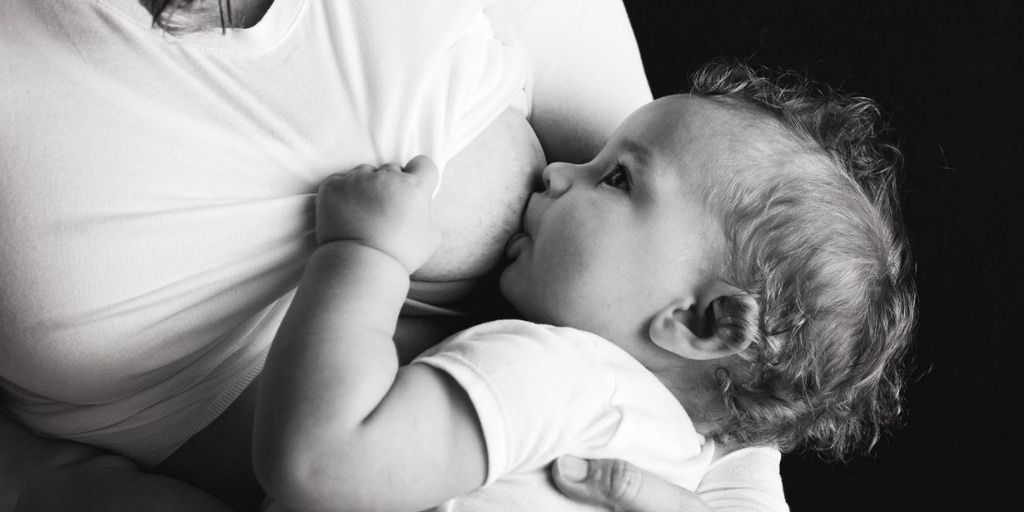
Do you want to give your baby the best chances of growing up healthy?
Do you dream of breastfeeding out of tenderness? Discover our ultimate guide to help you succeed.
Definition
Breastfeeding is the feeding method of an infant or child through breast milk. The mother naturally produces milk. When breast milk is insufficient, breastfeeding is a combination of breast and bottle feeding.
If for medical reasons, the mother cannot breastfeed, the baby is bottle fed, either with the breast milk drawn or with other milk produced in an industrial way.
Importance and benefits
Breast milk is specially adapted to meet the needs of the baby from birth. It's beneficial for the infant's health and development. Furthermore, breastfeeding also has benefits for the mother.
Breast milk is convenient because it is always ready. It is also economical.
Finally, it is ecological because it leaves no waste and requires no transport.
The Benefits of Breastfeeding for the Baby
There is a lot of scientific evidence on the benefits of breastfeeding.
- Breastfed babies are less often affected by infections. Their risk of gastrointestinal infections (eg, gastroenteritis and diarrhea) is significantly reduced compared to babies fed with commercial preparations.
- Breastfed babies also have a lower risk of upper respiratory infection (colds, flu). Breastfeeding also decreases the frequency of bronchiolitis, pneumonia and ear infections.
- Breastfeeding would be associated with a reduced risk of sudden infant death syndrome.
- Breastfeeding may have a protective effect against certain inflammatory diseases, for example: eczema, type 1 diabetes, inflammatory bowel diseases such as Crohn's disease.
- Some studies suggest that breastfeeding reduces the risk of being overweight and obese. However, the results of such studies are sometimes contradictory.
- The majority of studies have noted that breastfed children have better results in intelligence tests. It is an acceleration of cognitive development and the beneficial effect seems to diminish over time.

The Benefits of Breastfeeding for The Mother
The benefits of breast milk for infants are well known: optimal growth, increased protection against infections, etc. But did you know that breastfeeding is also good for the mother?
Weight loss
When you breastfeed, you burn about 840 kcal (2,800 kJ) for every liter of milk produced! And it is your fat reserves accumulated during your pregnancy that suffer the consequences. A nice way to lose weight!
Relaxation
Exhausted by the short nights? The hormones secreted during breastfeeding will give you a well-deserved sense of relaxation.
Emotional bond
Breastfeeding also plays an important role in the development of maternal instinct and increases the physical attachment between you and your baby.
A plus for your health
Breastfeeding to prevent osteoporosis? Eh yes! In addition, breastfeeding your child would reduce the risk of ovarian and breast cancer before menopause.
A simple solution
Breastfeeding can make your life easier when it's time to feed your baby. Your milk is always good, always fresh and always at the right temperature.
Available anytime, you can feed your baby anywhere, anytime. In addition, breastfeeding is economical!
Video Credit: Emily Norris' youtube channel.
Breastfeeding Essentials: How your milk is made
The production of breast milk is the subject of many myths. One of the common misconceptions is that a mother's breasts are like huge bottles that fill up with breast milk, regardless of what happens between the baby and her mother.
Thus, babies would feed themselves by opening a tap, to this inexhaustible reservoir. The truth is however more complex.
The breastfeeding process is based on the principle of "demand and supply" rather than the other way around. The mother produces only the quantities of milk that meet the infant's demand.
The maternal body is very effective since it does not produce more breast milk than the baby wants to drink! Mom only produces the amount of milk her baby needs.
It is true that hormones control the production of milk produced according to the hours of birth, namely colostrum. However, for milk production to continue, your baby must continue breastfeeding.
Total milk production varies according to the time the baby suckles and the amount of milk actually drunk. A mother produces the amount of breast milk that is related to her baby's genetics - since this element defines the growth rate and metabolism.
In the long run, a mother's body will produce an increased or reduced amount of milk to accurately meet baby's needs. The key is to create a familiar process, routine and environment that supports proper breastfeeding, reduces stress and allows baby to be comfortably breastfed.
This is one of the reasons that makes it important for mom and baby to be relaxed and comfortable.
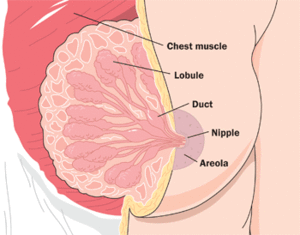
When the baby sucks its mother's breast, a hormone called oxytocin compels the milk to flow from the alveoli (lobules), through the ducts (milk canals) into the sacs (milk pools) behind the areola and then into the baby's mouth. (image credit wikipedia)
Transformation of breast milk during breastfeeding
Breast milk is filled with several vital nutrients that are essential for the baby's needs. It develops during the gestation of the woman. Breast lactation is triggered once the baby is born.
The regular and effective feeding of the newborn promotes the stimulation of breast milk. Breastfeeding can last up to about two years.
Breast milk knows different stages of transformation during breastfeeding. After childbirth, the first secreted breast milk is called colostrum. The stomach of the newborn adapts perfectly to this milk, since it is easily assimilated.
At the same time thick and translucent, the colostrum is characterized by an orange color. It is filled with antibodies that protect the young against microbial attack.
It comprises protein, of the order of 23 g / liter, oligosaccharides which are assimilable sugars, vitamins, free amino acids and mineral salts. The secretion of colostrum is minimal at first, about 20 to 50 ml at each feeding. But this volume increases as the effectiveness of the suckling.
A few days after delivery, colostrum is changed to colostrum, also called transition milk. This transition milk is formed by mature milk and colostrum.
The components contained in the colostrum undergo a transformation. The latter is characterized by a fluid consistency and an increase in volume.
How does milk production work to maintain an adequate supply?
During the first days after birth, when the milk rises, you may feel that your breasts are full of milk, that there are even too many! During the days and weeks that follow, it is normal for this feeling of abundance to diminish.
However, one of the biggest concerns for breastfeeding moms is that their breasts are never full of milk, and they do not produce enough for their baby, which can be stressful.
In turn, this may cause the amount of milk produced to be insufficient for the baby. Ironically, one of the ways to ensure adequate milk production is not to worry about it. Also, it is possible to reduce stress by understanding how the production of breast milk works.
Note the following basic principles:
- The more you breastfeed, the more baby becomes skilled at emptying your breasts, the more your body produces milk.
- Your body will produce more milk in response to stimulation of your breasts.
- Milk production accelerates in response to a breast that is empty.
- Milk is produced at all times. Breasts are never completely empty.
How to keep production on the rise to meet demand
Everything is centered on baby's demand! If your baby is growing at a decent rate, you give him all the milk he needs. Continue breastfeeding.
We recommend that you do not introduce any infant formula, at least not until your baby reaches six months of age, if you choose to do so. Remember that for the first six months, breast milk is the natural ingredient that gives baby all he needs for nutrients and immune protection.
Stimulate production by emptying the breasts. For this purpose, breastfeed more often and you can choose to add expression sessions between feedings.
Express your milk after breastfeeding if you feel that baby has not enough deflated both breasts. Breastfeed on both sides. Change the breast when the first breast is sufficiently deflated to tell you that baby has gotten the end-of-feed milk - the high-fat portion, which increases as the breast empties, is excellent for development of the baby's brain.
Finally, try to take care of yourself to be able to take good care of your baby. Every day, give yourself a break. Relax, and try to get enough sleep. Drink lots of water and have a balanced diet of nutritious foods.
Do not forget that you are not alone! Several options are offered to you as support for breastfeeding. If you are concerned about your milk production, talk to your doctor, pediatrician or breastfeeding consultant.
Pumping and storing your milk
Whether it is to relieve engorgement, because baby does not take the breast, in anticipation of an exit or a return to work, drawing milk can be very useful.
Here's what you need to know about different methods and how to preserve milk.
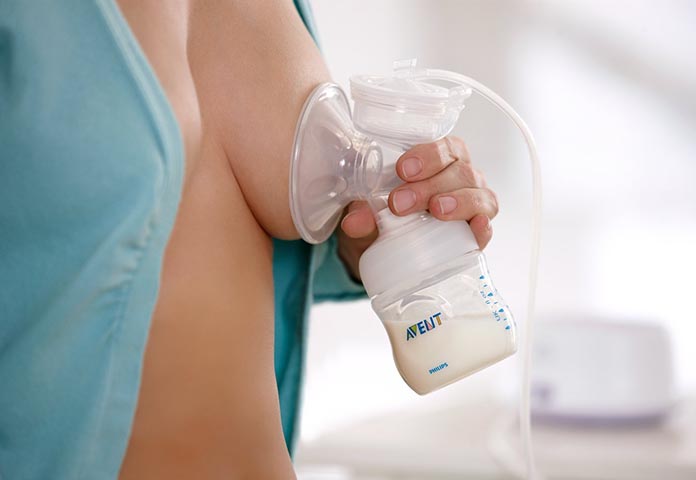
What are the methods to use?
Hand expression
This method is mostly used in the early days. It is simple, economical and effective as a breast pump. However, this method can be used to increase production.
Manual breast pump
This is the most affordable breast pump. It must be operated manually. It's enough if you use it occasionally. In the long run, however, this method could be detrimental to milk production.
Individual Electric Pump
It does not take effort, but it costs more. It is suggested that you draw your milk regularly for a short time. Some models can draw milk from both breasts at once, a method that further stimulates milk production.
Double Electric Breast Pumps
It allows you to draw milk from both breasts at a time. It is recommended if you pull your milk several times a day for several weeks. This breast pump is available for pharmacies and some breastfeeding charities, because its purchase price is high.
How to pump your milk?
It is important to follow the manufacturer's instructions when using a breast pump. Avoid, among other things, setting the suction to the maximum setting.
It should rather be set at the highest level for you, the goal is to imitate as much as possible feeding the baby without causing you pain.
How to do it and how often to draw milk depends on your situation.
- If you are separated from your baby or can not breastfeed.
Pull your milk as often as your baby would normally drink, that is, 8 to 12 times a day. However, it is important to know that in the long term, drawing milk could lead to a drop in production.
- If you draw your milk for an outing or a return to work.
Start drawing milk after a feed, several days or weeks (in the case of a return to work) in advance. Pulling your milk at the same time every day will stimulate your body to produce more milk at this selected time of day. Since most women produce more milk in the morning, this may be a good time to do so.
How to store breast milk?
Milk can be put into glass containers, rigid plastic containers or freezer bags designed for breast milk .
It can thus be preserved:
- 4 hours at room temperature;
- 8 days in the refrigerator;
- 6 months in the freezer of the refrigerator;
- 12 months in a chest freezer.
The shelf life does not add up. So you cannot leave the milk for 4 hours at room temperature, then 8 days in the refrigerator and 6 months in the freezer.
Freeze your milk in small amounts (30 ml to 90 ml or 1 to 3 ounces). This avoids waste.
Also note on the container the date the milk was drawn in order to use the oldest milk first.
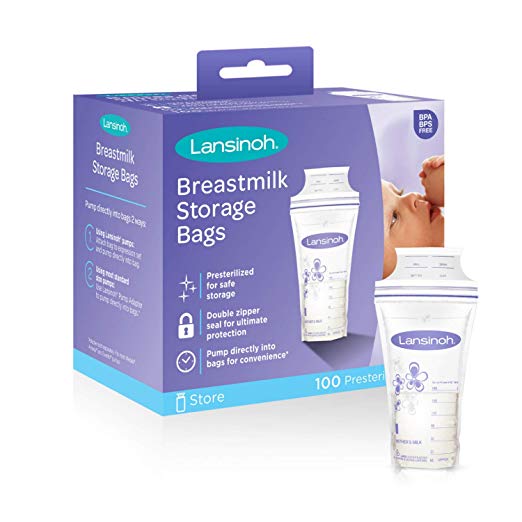
How to defrost it?
Breast milk can be thawed in the refrigerator or by immersing the container in a bowl of warm water. Never thaw breast milk in the microwave.This method heats the milk unevenly.
The milk may be too hot in some parts of the bag or bottle and pose a danger to the baby. In addition, when heated to high temperatures, breast milk loses some of its properties.
Once thawed, if the milk has not been heated, it will keep for 24 hours in the refrigerator and 1 hour at room temperature. It must not be refrozen. In addition, the milk remaining after a drink must be discarded.
Change in taste
In some women, the enzymes (lipases) that help babies digest milk fat are very active. This can give a bad taste to breast milk once thawed (soapy taste).
Your baby may then refuse to drink it. If this is your case, it is possible to reduce the action of lipases by simmering for a few minutes your freshly drawn milk on the fire (it should not boil). Then cool your milk in cold water or in the refrigerator, then freeze it. This should allow your milk to keep its good taste.
Types of breastfeeding: different positions

There are several positions for breastfeeding: semi-sitting (also called "biological position"), Madonna, football and lying down. Ask a nurse or the person accompanying you to help you experiment them from the first days. You can then choose the one you find most comfortable.
It is possible to feel discomfort the first days, because the nipples are then more sensitive. Generally, the pain passes after a few seconds and is not experienced until the first week. It is also possible that the suction is not optimal from the start, which causes this sensitivity.
If the pain persists, even after correcting the breast, it is suggested to see a lactation consultant. Pain that persists is not normal and could mean a bigger problem.
Experts recommend varying breastfeeding positions to:
- Stimulate all areas of the breast
- Avoid pain by varying the position of the baby's mouth on the nipple
Here are some of the breastfeeding positions you can try:
To begin, lay your baby on a cushion, his chin touching your breast. His ear, shoulders and hip should be aligned.
Lying on your side
You and your baby lie on your side, face to face with pillows placed behind your back and your baby's and under your head. The baby's head is resting on your arm or on the bed.
This position allows you to rest or stay in bed to breastfeed at night.
Position in Madonna
Baby is installed in front of you. His head rests on your forearm and his body is on his side, lying on a nursing pillow. You are sitting, relaxed, standing upright (without leaning forward) with a cushion in the back.
Elongated position
Baby is lying next to you on a cushion. You support his back with your arm. This is an interesting position after a cesarean section.
Football hold Position
The baby is supported by a breastfeeding cushion and wedged under your arm on the offered breast side. The baby is lying on his side, his body facing yours.
Position in semi-reclining chair
You are in a semi-recumbent position and your baby is lying on your stomach. To try if the feedings are painful or if your baby has difficulty to hang on the breast.
Signs that show your child is nursing well:
- The mouth and lips of the baby cover a large part of the areola ;
- The lower lip of baby is rolled outward;
- The baby's tongue is positioned in a gutter under the nipple ;
- You see the joints move near your baby's forehead and ears when he begins to suckle and swallow;
- Your baby sucks at his own pace: he makes sucking movements for a few seconds, stops to swallow, then starts again;
Common Challenges
Breastfeeding is a decision that often raises a lot of concerns. Should you give up your freedom and sleep? Will your breasts be damaged? Can your hay fever stop you from breastfeeding?
To all these questions, short answers for you: no. A quick tour of the main obstacles to breastfeeding and their solutions.
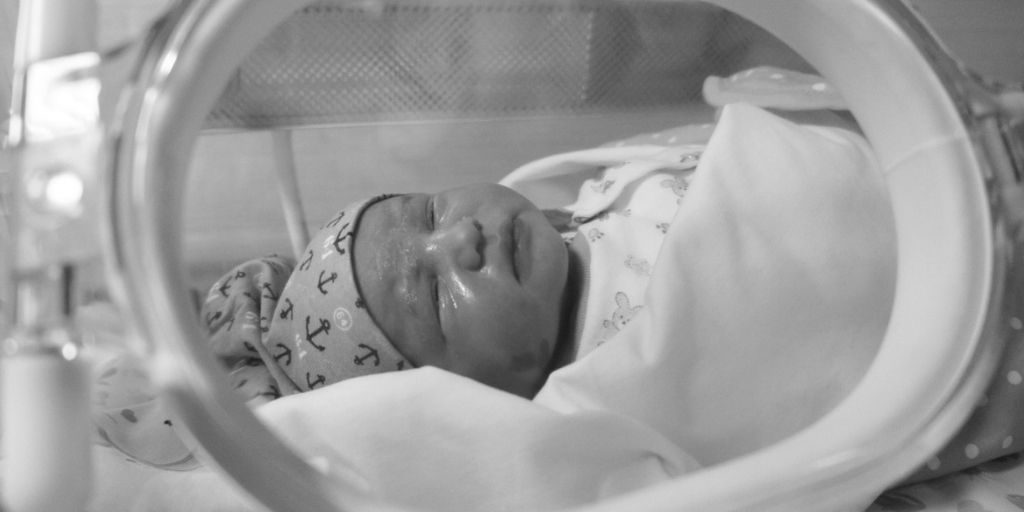
Loss of freedom
Are you afraid of losing your freedom while nursing your baby? Of course, a newborn baby requires a lot of time and attention. Breastfeeding also requires being always present at the time of the feed.
Never mind! Go out with your baby and breastfeed on the spot. You will take a bit of fresh air and you will change your ideas. Enjoy the fact that you do not have a bottle to prepare and heat! You are much freer than you think.
Reduced hours of sleep
Would you like Dad to give you a hand, especially at night, so that you can rest? Exclusive breastfeeding requires that you wake up several times a night. But do not worry. Only for a few weeks.
When napping, take the time to do the same. Accept the help of those around you and focus your energies on you and your baby.
Dad can help you in many other ways too:
- changing the baby diaper at night;
- bringing you baby in bed for you to nurse;
- dealing with shopping, meals and housework.
From the 6th week, milk production stabilizes. You can then draw your milk and give it to Dad and other members of your family.
The leaks
Do you fear unsightly leaks? Rest assured! There are now cups and cotton pads designed to hide the milk losses that may occur.
Broken breasts
Stretch marks, scars, deformities ... What damages the breasts are abrupt changes in volume, such as weight gain in early pregnancy, engorgement the first days or sudden weaning.
Avoid this discomfort by putting baby on the breast quickly, increasing the number of feedings during the first few days and gently weaning.
In the case of heavy and bulky breasts, a good breastfeeding bra is essential, day and night, to support the breasts without compressing them.
Diseases and drugs
Do you suffer from hay fever? Do not worry! Few diseases prevent breastfeeding, with the exception of breast cancer, HIV infection, drug use, high alcohol consumption, certain medications and infectious diseases such as tuberculosis, malaria or typhoid fever.
Most medications go into your milk at concentrations too low to affect your baby. Some are, however, contraindicated. These drugs can often be replaced by safer medications. Talk to your pharmacist.
The first 6 weeks of breastfeeding can be stressful and you may want to stop breastfeeding. Allow yourself time to adapt to your new life and your baby. Do not be too demanding.
You will realize that after the 6th week you will have your way to go, you will be more in control and you will see the situation from a completely different perspective.
The cooperation and encouragement of your spouse is essential for successful breastfeeding. Talk together before your delivery. You will be ready to overcome the most difficult moments and give your baby the best gift.
Breastfeeding vs formula feeding

Breast or bottle?
What choice will you make for your baby?
This is a very personal decision. But before deciding, it is essential to have all the existing information.
Breastfeeding
Health professionals agree that breast milk offers incomparable benefits for your baby. Rich in antibodies, it adapts to the needs of the child and is therefore ideal for infants.
Breastfeeding is also a unique experience that helps strengthen the bond between you and your child . It is also the cheapest way to feed your baby.
Breastfeeding is a natural act, but it can sometimes cause some inconvenience. If it does not happen the way you want, do not be discouraged! It takes an average of 3 weeks for the process to take place.
PROS
.
CONS
Mixed breastfeeding
Even if you are breastfeeding, the father can also participate if you opt for mixed breastfeeding. For example, you can breastfeed and bottle-feed your milk or combine breast milk and powdered milk.
In order for others to feed your baby, you will need a breast pump and baby bottles.
PROS
.
CONS
.
Bottle feeding
Some mothers choose, for various reasons, not to breastfeed. It's a personal decision, you do not have to feel guilty.
In any case, breastfeeding will not be a positive experience if you do not want to breastfeed. Infant formula will give your baby all the essentials he needs to grow, do not worry.
What will you need to feed your baby with a bottle?
Feeding a bottle to a baby snuggled against you is a very sweet moment that you can share with the father so that he too can enjoy these precious moments.
There is a range of accessories to facilitate bottle-feeding, even for toddlers.
Read this article to help you find the most suitable bottles and teats .
PROS
.
CONS
How to increase breast milk
When breastfeeding, mothers do not need to have a perfect diet . However, it is important that they choose healthy foods and eat a balanced diet to restore their nutritional reserves after delivery and thus avoid burnout.
They can also eat foods that were not recommended during pregnancy (eg sushi, unpasteurized cheese).

Breastfeeding diet
Eat one's fill
To produce milk, your body needs extra calories. Some of these calories come from the reserves you have accumulated during pregnancy. The other part is provided by your diet. Thus, to produce enough milk, you just have to eat your fill.
Some mothers even say they have more appetite during breastfeeding . This is normal, and they should not worry or limit the amount of food they eat.
Most mothers who are breastfeeding lose weight gradually within six months of delivery. Subsequently, their weight stabilizes.
Here are some helpful tips to guide you in your diet:
To be sure of eating all the nutrients that are essential to your health and that of your baby.
In addition to your three daily meals, have some healthy, nutritious snacks, such as fruit , vegetables, muffins, whole grain bread, cheese, yogurt.
If you eat well, you do not need to take vitamin and mineral supplements. However, if you are a vegetarian and do not consume any animal products, it is recommended to take a vitamin B12 supplement.
Indeed, a deficiency of certain vitamins in the mother could lead to a decrease in the level of these vitamins in her milk.
Listen to your thirst. If your urine is dark, it may be a sign that you do not consume enough water.
Be aware, however, that drinking a large amount of fluid will not increase the amount of milk you produce. In addition, the belief that one has to drink milk to produce milk is false.
Does baby reacts to mom's milk?
It has long been believed that some foods, such as cabbage, onions or spicy foods, are a problem for babies. We know today that these adapt well yet very well. In fact, it is rather rare for a baby to react to a food that his mother has eaten.
In the first year, it is estimated that only 5% of breastfed babies will have such a reaction, the responsible food being cow's milk in the majority of cases. See our fact sheet on milk allergy for more information.
Other foods that can also cause reactions are eggs, peanuts, nuts, wheat, soybeans and fish.
If your child seems to be reacting to a food you eat, it is suggested that you give up that food for a while and monitor your baby's reaction. Most of the time, the symptoms will usually disappear in 24 to 48 hours.
However, if it is a food that you consume regularly, such as dairy products , it may take two to three weeks for any trace to disappear from your metabolism.
If your baby is better after the food has been eliminated, start using it again. If the symptoms return, this food is probably the cause and you must remove it from your diet for good. However, consult a nutritionist to avoid nutritional deficiencies.
If your baby is not better, he may be intolerant or allergic to another food or he has another health problem. In this case, talk to your doctor.
Foods to make more milk?
In many cultures, new mothers are advised to consume certain foods to increase milk production, such as oats, almonds, rice, chicken and various herbs.
Although some women say they have had some success with these methods, no scientific study has been able to confirm their effectiveness.
Moreover, contrary to popular belief, beer does not increase the amount of milk produced by a mother. Alcohol has the effect of reducing milk production. Barley in beer, however, may stimulate the secretion of prolactin, a hormone that plays a role in breastfeeding. Yeast beer would not have this effect.
If your milk production is inadequate, increase the frequency of feedings and make sure your breasts are empty after each drink. If you still have no milk, talk to your doctor. He may prescribe a drug that helps increase milk production.
What foods to avoid while breastfeeding?
The caffeine quickly passes into breast milk. Do not drink more than two cups a day of tea, coffee, hot chocolate or soft drinks like cola.
On the other hand, herbal teas and other decaffeinated drinks are no problem. Choose linden, mint, raspberry and fruit tea.

Avoid energy drinks because they contain substances that can be dangerous for your baby.
Limit consumption of canned white tuna to 300 g per week because it contains more mercury than light tuna. On the other hand, no limitation applies to canned light tuna.
Avoid eating more than once a month (max 150 g) fresh or frozen tuna, shark, swordfish, escolar, marlin and orange roughy, bass, pike , walleye, muskellunge, lake trout, caviar and fish liver , because these foods absorb more pollutants than others, including mercury, which could harm your baby.
The liquor passes into the milk and each glass of alcohol takes two to three hours to be removed from the breast milk. The elimination time varies according to your weight.
The American Academy of Pediatrics, however, considers that alcohol consumption is compatible with breastfeeding. Indeed, the alcohol consumed occasionally or regularly in small quantities does not seem to be harmful for the breastfed baby.
However, regular alcohol abuse can slow down the baby's weight gain and affect its development. Alcohol consumed in large amounts may also inhibit the ejection reflex in some mothers.
Avoid smoking cigarette or breastfeeding immediately before smoking, as nicotine is found in breast milk in addition to harm production.
Your baby may become irritable, cry, and have insomnia due to nicotine. In addition, avoid smoking in the presence of your baby. If you want to use nicotine patches or nicotine gum to stop smoking, consult your doctor.
Food to decrease milk production?
Sage, parsley and peppermint are traditionally used to reduce milk production. Sage and parsley are particularly recommended in case of overproduction of milk or to facilitate weaning.
However, no scientific study has been conducted to evaluate the actual effect of these herbs on milk production. In addition, breastfeeding experts generally agree that the quantities used in cooking are too small to interfere with breastfeeding.
Breastfeeding Tips
It is possible to live a harmonious breastfeeding by following some basic tips. We present you 12.
- Give your child breast as soon as possible after birth, ideally within the first 60 minutes.
- Keep your baby close to you, day and night. You can breastfeed while lying down if you wish.
- Be convinced that your milk is perfect for your newborn: it is nourishing, rich and fattening. It's a wonderful healthy gift!
- Breastfeed your child as needed, depending on your hunger. Frequent feedings stimulate milk production.
- Learn to recognize the signs of your child's hunger. He will have a very personal way of letting you know that he is hungry.
- Make sure your baby is breathing well, getting a good breast, sucking, and getting the milk he needs.
- So as not to interfere with lactation, do not skip breast feeds, give your baby a lollipop or give him another milk before 4 weeks.
- Whenever possible, wait until your baby is 6 months old before giving him another milk and solid foods; he will better enjoy all the benefits of breast milk.
- Cut short worries. As soon as a worry or discomfort arises, contact the CLSC nurse, a breastfeeding support group in your area or a breastfeeding clinic.
- Slow down. Breastfeeding a child is also taking the rhythm of a new life. Leave aside the side tasks and get help for the essentials.
- Think of yourself. Give yourself moments of rest and peace to recover sleep inevitably interspersed
- Trust yourself! The success of your breastfeeding experience will be increased if you trust yourself!
.
Common Questions

How long does the average mom breastfeed?
You are pregnant, you want to breastfeed, but you wonder how long? How long does it take to breastfeed? How long do you want to breastfeed? What is the good answer? Or rather, what is the right question to ask?
Is it so important to decide now, during your pregnancy, until when are you going to breastfeed? You can think about it, discuss it with your spouse, family and friends.
This will allow you to hear their experiences, opinions, and help you define your position on the issue. You can set a goal and then see how your breastfeeding goes, see how you feel about your breastfeeding and let go of things day after day, one day at a time.
Official recommendations
To help us find the answer, there are the official recommendations of the World Health Organization that are repeated by the Canadian Pediatric Society and Health Canada: "Exclusive breastfeeding is recommended until six months old. From six months to two years or more, breastfeeding must be supplemented by another diet. ".
How do I get my milk to let down?
Less milk? First, rest: lie down, sleep and slow down your chores.
Breastfeeding makes you thirsty! Drink to quench your thirst! Fennel herbal teas seem to be a good way to boost milk production.
Yeast beer can make up for a lack of vitamin B complex (which it is, actually!). Warning! Too much yeast can cause rashes (in the baby) or bloating (in the mother).
Remember: the more the breast is stimulated, the more milk comes out and the bigger the production!
Your diet can also influence your milk production.
Can you get pregnant while breast feeding?
It is very important that you know that there are risks of getting pregnant during and after breastfeeding.
Having a child requires a lot of energy and personal investment, so it is your job to avoid any new pregnancy that is too close if you do not want to feel overwhelmed.
Know that breastfeeding is not an effective and infallible method of contraception and even less a 100% safe method, even if it is true that breastfeeding helps to have no period. However, breastfeeding can prevent pregnancy in more than 98% of cases if all of the following conditions are met.
If you have had no menstruation or simple blood loss after 56 days or 8 weeks after delivery.
If breastfeeding is exclusive for a baby under 6 months of age, that is to say, you breastfeed only day and night and eat no other food than your milk.
If your baby does not sleep more than 6 hours and therefore you breastfeed in periods not exceeding 6 hours.
In the event that only one of these conditions is not respected, plan without delay an effective method of contraception.
Is breastfeeding good for weight loss?
Feeding your child is normal and becomes from the first day, a gesture that you will repeat several times daily. But you could not imagine that this maternal and natural process could help you eliminate the few extra pounds you took in recent months!
It has been found that breastfeeding women burn calories faster. Indeed, producing breast milk is not easy for your body. During your pregnancy, you have accumulated fat to meet the needs of your baby. Today, your body can in this fat to find the energy it needs during feedings. This period allows you to eliminate a number of calories to each liter of milk that baby ingests.
Can I take medicine while breastfeeding
Some women have to mourn breastfeeding because they are taking medication. Fortunately, these cases are rare. Explanations and recommendations.
The breastfed child receives at most 1% of the dose taken by the mother when she takes an oral medication. Stopping breastfeeding or not breastfeeding is therefore rarely justified
Nevertheless, some medications cause concern and that is why for each patient, the doctor and the pharmacist must take into account several elements before pronouncing their verdict.
Please consult your doctor or pharmacist if you are concerned about medication while breastfeeding.
A glass of wine: yes or no?
Yes, if you feel like it. "The alcohol is found in breast milk between 15 and 30 minutes after consumption and is eliminated as soon as the effects felt by the mother dissipate," writes Dany Gauthier in the book Breastfeeding, Editions of the hospital Sainte-Justine. Thus, without excess, moderately and occasionally, it is permissible to drink alcohol, but it is better to take it after giving the breast.
I have a gastro. Do I continue to breastfeed?
Yes! By continuing to breastfeed, you pass your antibodies to your baby. These protect your child who would still be exposed to the virus even if you stopped breastfeeding. It is also possible to draw your milk as long as you forget about hygienic precautions (wash your hands and sterilize your baby bottles).
Should the number of feedings and the duration of feedings be calculated?
No more comparisons! A newborn fed formula will take about 6 to 7 bottles per day, but a breastfeeding baby will take 8 to 12 feeds (sometimes more!) A day in the first few weeks. Breastfeed your child at your request without worrying about the interval between drinks.
It is also not advisable to time the feeding time. The composition of each woman's milk varies during a drink. First, the milk contains a lot of water to quench the thirst of the baby, then it thickens becoming richer to fill his hunger. One child may take 10 minutes for one drink and another for an hour while being both satiated.
Cracking warning: what to do?
As often as possible, leave your breasts bare. There are several creams and ointments to apply on the breasts, but easier and more accessible than anything: put a few drops of your milk on your bruised nipples. Let the milk air dry before putting your bra back on; it will relieve you. Remember that cracks are often caused by a bad position . Ask a breastfeeding sponsor or girlfriend for help.
I want to draw my milk, but it does not run during the expression. What to do?
Try these:
- Take a hot shower before drawing your milk. Take the opportunity to relax!
- Gently apply a warm moist compress to your breasts.
- Drink a hot drink.
- Make skin to skin with your baby.
- Ask your spouse to massage at the shoulder blades.
- Relax! Do not do it under pressure.
Using the breast pump on one breast while baby is at the other will stimulate the ejection reflex and the milk will come out more easily and quickly.
Son has his first tooth. During breastfeeding, he just bit me and pull my breast with his tooth. It's painful: what to do?
As soon as your baby bites you or when you feel an unusual pressure, you break his suction (with your little finger inserted in the corner of his mouth to prevent it hurts) and say "no" with a firm voice and more strong than usual. You can also stop breastfeeding to tell him that he can not do that and keep drinking.
The secret is to be firm and not to falter in front of his first tears. If your child persists, you can, as a last resort, gently bury your head in your breast for one or two seconds. His nostrils will clog and he will automatically release the suction.
I am pregnant I'm scared of not being able to live the breastfeeding experience. What to do?
Trust yourself.
Surround yourself: ask your spouse to support you. Explain to him why it is important for you to breastfeed.
Do not hesitate to turn to a breastfeeding godmother to support and educate you. Call your parent organizations in your area to find out about your neighborhood's resources.
Your girlfriends are also good resources. Ask them questions, they will surely be happy to tell you about their experience.